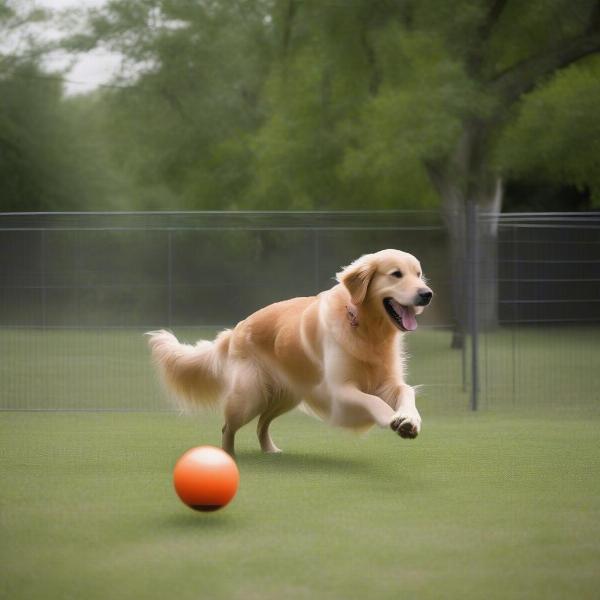Trees are a ubiquitous part of our environment, offering shade, beauty, and even a climbing challenge for adventurous canines. But how do trees and dogs interact, and what should owners be aware of to ensure both the safety of their pets and the preservation of their leafy companions? This guide will explore the various aspects of the “trees and dogs” dynamic, from potential hazards to opportunities for enrichment.
Understanding the Risks Trees Pose to Dogs
While trees may seem harmless, certain aspects can present risks to your furry friend. Toxic sap, prickly bark, and falling branches are just a few examples. Some trees, like the Black Walnut, produce juglone, a toxin that can be harmful to dogs if ingested. Likewise, certain fruits and seeds from trees, such as acorns and conkers (horse chestnuts), can cause gastrointestinal upset or even more serious health issues if eaten by your dog.
It’s also important to consider the structural integrity of trees, especially during storms or high winds. Falling branches can cause significant injury to a dog, and even seemingly sturdy trees can become hazardous in extreme weather. Additionally, some dogs may be tempted to chew on or ingest tree bark, which can lead to splinters, choking, or digestive problems. Certain types of bark contain toxins that can be harmful if consumed.
Creating a Safe Outdoor Environment with Trees
Maintaining a safe environment for your dog around trees involves regular inspection and proactive measures. Regularly check your yard for fallen branches, poisonous plants, and any other potential hazards. If you have trees with toxic sap or fruits, consider fencing them off or training your dog to avoid them.
 Dog Playing Fetch in a Safe, Fenced Yard with Trees
Dog Playing Fetch in a Safe, Fenced Yard with Trees
When walking your dog in wooded areas, be mindful of their surroundings. Keep them on a leash to prevent them from ingesting potentially harmful plants or venturing into areas with unstable trees. Teaching your dog a reliable “leave it” command can be invaluable in preventing them from chewing on or eating dangerous items found near trees.
Utilizing Trees for Canine Enrichment
Trees can also be a great source of enrichment for your dog. The scent of trees, the texture of bark, and the rustling of leaves can stimulate their senses and provide mental stimulation. You can incorporate trees into your dog’s playtime by hiding toys in the branches or using tree trunks for scent work activities.
Climbing trees, under supervision and in appropriate environments, can also be a fun and challenging activity for some dogs. However, ensure the tree is sturdy and safe for climbing, and always supervise your dog to prevent falls or injuries. You can also create a natural agility course using fallen logs and branches, providing physical and mental exercise for your canine companion.
Conclusion: Balancing Safety and Enrichment with Trees and Dogs
Trees are an integral part of our landscape and can offer both risks and rewards for our canine companions. By understanding the potential hazards and taking proactive steps to create a safe environment, you can ensure your dog enjoys the benefits of nature while staying protected. Simultaneously, incorporating trees into your dog’s playtime and enrichment activities can provide valuable mental and physical stimulation, fostering a healthy and fulfilling life for your furry friend. Remember to always supervise your dog around trees and consult with your veterinarian if you have any concerns about their safety or well-being.
FAQ:
- Are all trees poisonous to dogs? No, not all trees are poisonous, but many common trees contain toxins that can harm dogs if ingested. It’s crucial to research the trees in your area and take precautions.
- What should I do if my dog eats something from a tree? Contact your veterinarian immediately. Provide as much information as possible about what your dog ate and how much.
- Can my dog climb any tree? No, not all trees are safe for climbing. Ensure the tree is sturdy and free from hazards before allowing your dog to climb it, and always supervise them.
- How can I prevent my dog from chewing on trees? Training a reliable “leave it” command and providing alternative chew toys can help discourage tree chewing.
- Are pine trees toxic to dogs? While the wood itself isn’t highly toxic, the pine needles and sap can cause gastrointestinal upset and skin irritation.
Related Articles on ILM Dog:
ILM Dog is a leading international online resource dedicated to providing expert advice on dog care and wellbeing. From breed selection and health to training, nutrition, and grooming, we offer comprehensive information to empower dog owners worldwide. We cover various topics including dog breeds, health, training, nutrition, grooming, and product reviews to support you in providing the best possible care for your canine companion. For expert advice on your dog’s specific needs, contact us via email at [email protected] or by phone at +44 20-3965-8624. ILM Dog is committed to helping you build a strong, loving, and lasting bond with your furry friend.